Last Updated on 5 months by Francis
Are you considering using an infrared propane heater indoors but worried about its safety? It’s important to gather accurate information before making a decision. In this article, we will delve into the topic of infrared propane heaters and their suitability for indoor use. By understanding the facts and following proper safety precautions, you can ensure a comfortable and safe heating experience for you and your loved ones.
Contents
Key Takeaways:
- Infrared propane heaters used indoors are generally safe when proper safety precautions are taken.
- Avoid extreme heating that may lead to fires or burns.
- Do not stare at the heater for extended periods to prevent eye damage.
- Ensure the electrical cords are in good condition and the heater is not placed too close to flammable materials.
- Using outdoor propane heaters indoors can be extremely dangerous, as they may produce harmful gases, such as carbon monoxide.
Understanding Infrared Propane Heaters

Infrared propane heaters are a popular choice for both outdoor and indoor heating. These heaters utilize infrared radiation to generate heat, providing a warm and comfortable environment. When using infrared propane heaters indoors, it is important to understand their safety features and precautions to ensure a safe and efficient heating experience.
How Do Infrared Propane Heaters Work?
Infrared propane heaters work by emitting infrared radiation, which directly heats objects and people in its path. Unlike traditional heaters that warm the air, infrared heaters transfer heat through electromagnetic waves. This method of heating is efficient and effective as it directly warms the desired objects or individuals without wasting energy on heating the surrounding air. As a result, infrared propane heaters can provide targeted and instant warmth in indoor spaces.
Safety Precautions for Indoor Use
While infrared propane heaters are generally safe for indoor use, it is important to follow certain safety precautions to minimize any potential risks. Here are some key safety measures to keep in mind:
- Ensure proper ventilation: Adequate ventilation is crucial when using propane heaters indoors. Make sure the room is well-ventilated to prevent the accumulation of carbon monoxide and ensure fresh air circulation.
- Keep a safe distance: Maintain a safe distance between the heater and any flammable objects, such as curtains or furniture, to reduce the risk of fire hazards.
- Monitor the heater: Regularly check the heater for any signs of damage or malfunction. If you notice any unusual smells, noises, or issues with the ignition, it is important to address them immediately.
- Follow manufacturer’s instructions: Always read and follow the manufacturer’s instructions for your specific infrared propane heater model. This includes guidelines for installation, usage, and maintenance to ensure optimal safety and performance.
By understanding the operation and safety precautions associated with infrared propane heaters, you can confidently use them indoors to provide efficient and comfortable heating in your living spaces.
The Safety Precautions for Indoor Use

When using infrared propane heaters indoors, it is important to prioritize safety and follow specific precautions to mitigate potential risks. By taking the necessary measures, you can ensure a safe and comfortable environment for yourself and your loved ones.
Proper Ventilation
One of the key safety considerations for indoor use of propane heaters is ensuring proper ventilation. Propane heaters emit carbon dioxide (CO2) as part of the combustion process, which can be harmful when accumulated in an enclosed space. To prevent the buildup of CO2, it is crucial to maintain adequate airflow in the room. Open windows or doors periodically to allow fresh air to circulate and ensure that the heater is not placed in a confined area.
Maintaining Clearances
To minimize the risk of fires or burns, it is important to maintain appropriate clearances around the heater. Keep flammable materials at a safe distance from the heater to prevent accidental ignition. Make sure there are no curtains, furniture, or other objects that can come into direct contact with the heater. Providing sufficient clearance ensures that the heater can function safely without posing a threat to surrounding objects.
Regular Inspections and Maintenance
Regular inspections and maintenance are vital to ensure the safe operation of the infrared propane heater. Check the heater’s components, such as the burner, fuel lines, and electrical connections, for any signs of damage or wear. Clean the heater regularly to remove dust or debris that can affect its performance. It is also recommended to have a professional technician inspect and service the heater periodically to identify any potential issues and ensure its continued safe operation.
Electrical Safety
When using an infrared propane heater, pay attention to electrical safety to reduce the risk of accidents. Ensure that the electrical cord and plug are in good condition, without any frayed wires or loose connections. Avoid using extension cords and instead plug the heater directly into a grounded outlet. Additionally, it is crucial to follow the manufacturer’s instructions regarding the appropriate power supply and usage guidelines to prevent electrical hazards.
By following these safety precautions, you can confidently enjoy the benefits of using an infrared propane heater indoors, knowing that you have taken the necessary steps to create a safe and comfortable environment.
The Role of Certification in Safety
When it comes to using infrared propane heaters indoors, safety is of utmost importance. One crucial aspect to consider is the certification of the heaters. Choosing heaters that have been specifically designed and certified for indoor use ensures that they meet the necessary safety standards and incorporate essential safety features.
Certified indoor heaters undergo rigorous testing to ensure their safety and compliance with industry standards. These heaters are built with features such as flame failure devices and oxygen depletion sensors, which help minimize the risk of accidents and harmful emissions. They are also equipped with proper ventilation systems to ensure the safe dispersal of combustion gases.
By selecting certified indoor heaters, you can have peace of mind knowing that you are using a product that has been thoroughly tested and approved for indoor use. These heaters provide a safer alternative to outdoor propane heaters, which can produce carbon monoxide and pose significant risks when used in enclosed spaces.
| Benefits of Certified Indoor Heaters | Drawbacks of Non-Certified Heaters |
|---|---|
|
|
When it comes to the safety concerns of using infrared propane heaters indoors, always prioritize the use of certified heaters. Ensure that the heater you choose has the necessary certifications and meets the required safety standards. Following manufacturer guidelines and practicing proper maintenance and inspection routines will further enhance the safety of using infrared propane heaters indoors.
The Dangers of Outdoor Propane Heaters Indoors
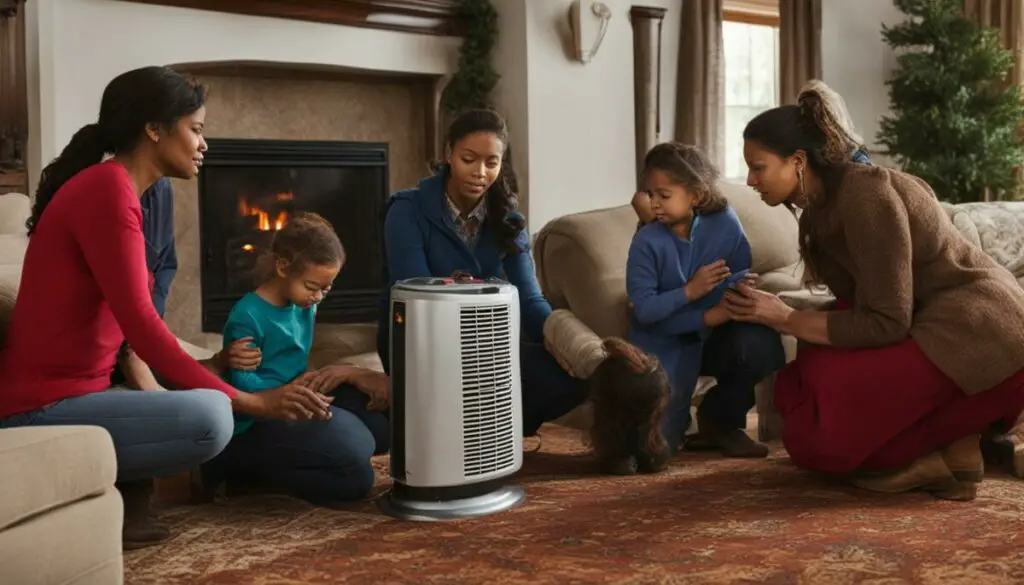
It is crucial to understand the risks of using outdoor propane heaters indoors. While infrared propane heaters designed for indoor use are generally safe, outdoor heaters pose significant dangers when used in an enclosed space. Outdoor heaters, including propane models, may emit carbon monoxide (CO) as part of their combustion gases. Carbon monoxide is a colorless and odorless gas that can be extremely harmful when inhaled.
Using outdoor propane heaters indoors can lead to carbon monoxide poisoning, which can be fatal. Carbon monoxide poisoning occurs when the gas builds up in an enclosed area, displacing oxygen and preventing the body from receiving the oxygen it needs. Symptoms of carbon monoxide poisoning include dizziness, headache, nausea, confusion, and in severe cases, loss of consciousness or death.
To ensure the safety of you and your loved ones, it is essential to never use outdoor propane heaters indoors. Instead, choose infrared propane heaters specifically designed for indoor use, as they are built with safety features to minimize the risk of carbon monoxide emissions. These indoor heaters are certified and tested to meet strict safety standards, providing peace of mind for indoor heating.
Indoor Gas Heaters vs. Outdoor Heaters
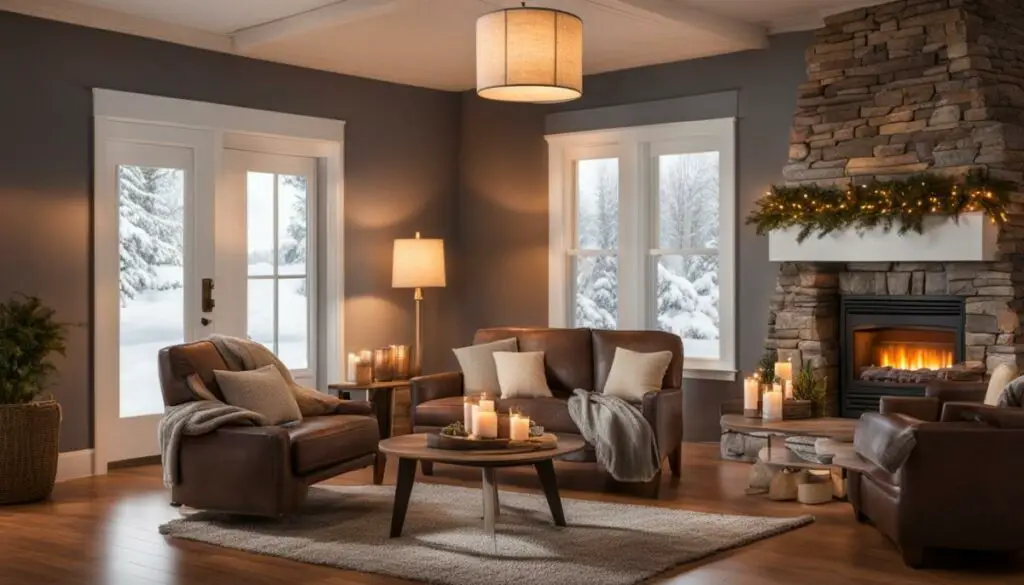
When it comes to heating your indoor space, it’s important to understand the differences between indoor gas heaters and outdoor heaters. While both types of heaters serve the purpose of providing warmth, their designs and safety features vary significantly.
Indoor gas heaters are specifically designed for use indoors, ensuring the safety and well-being of your family. These heaters are built to meet strict emission standards and incorporate safety features such as flues to vent combustion gases outdoors. They eliminate or minimize the production of carbon monoxide, making them safe for indoor use.
On the other hand, outdoor heaters are not subjected to the same emission standards as indoor heaters. They prioritize outdoor use, where ventilation is generally unrestricted. The use of outdoor heaters indoors can be extremely dangerous, as they may produce carbon monoxide as part of their combustion gases. Carbon monoxide is a colorless and odorless gas that can be harmful when used in an enclosed space.
Therefore, it is crucial to only use propane heaters that are certified for indoor use. These heaters are designed to ensure the safe heating of indoor spaces, providing you with warmth and comfort without compromising your safety.
Safety of Infrared Propane Heaters for Indoor Use
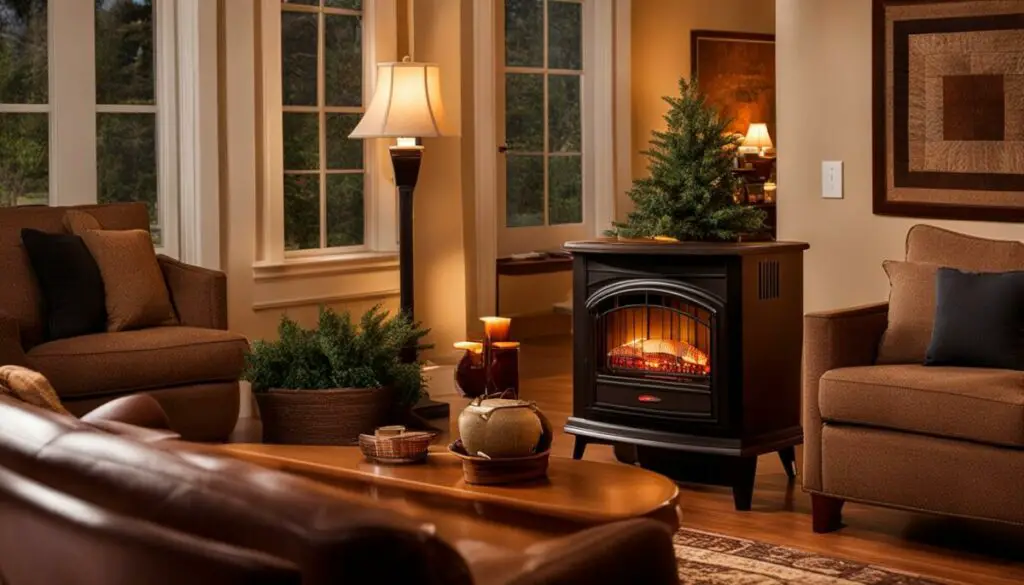
When it comes to the safety of using infrared propane heaters indoors, it’s important to understand the key differences between outdoor and indoor heaters. While outdoor heaters are designed for open spaces with unrestricted ventilation, indoor heaters must comply with strict emission standards to ensure safe usage in enclosed spaces.
Indoor gas heaters are specifically built for safe indoor use, incorporating various safety features and meeting required certification standards. These heaters prioritize the well-being of occupants by minimizing or eliminating the production of carbon monoxide, a potentially harmful byproduct of combustion.
Using outdoor propane heaters indoors can be extremely dangerous due to the risk of carbon monoxide poisoning. These heaters are not subjected to the same emission standards as their indoor counterparts and should never be used in enclosed spaces.
The Importance of Indoor Heater Certification
To ensure the safety of infrared propane heaters used indoors, it is crucial to choose heaters that are designed and certified for indoor use. Certified indoor heaters undergo rigorous testing to meet safety standards and incorporate features that mitigate the risk of accidents or harmful emissions. When purchasing an indoor heater, look for certifications from reputable organizations to ensure the highest level of safety for you and your family.
By following the recommended safety precautions, using certified indoor heaters, and understanding the differences between outdoor and indoor heaters, you can enjoy the warmth and comfort provided by infrared propane heaters while keeping your indoor environment safe.
| Indoor Propane Heaters | Outdoor Propane Heaters |
|---|---|
| Designed for safe indoor use | Designed for open spaces with unrestricted ventilation |
| Comply with strict emission standards | Not subjected to the same emission standards |
| Include safety features to minimize carbon monoxide production | May produce carbon monoxide as part of combustion gases |
| Require adequate ventilation in enclosed spaces | Not recommended for indoor use |
Radiant Outdoor Heaters and Ventilation Needs
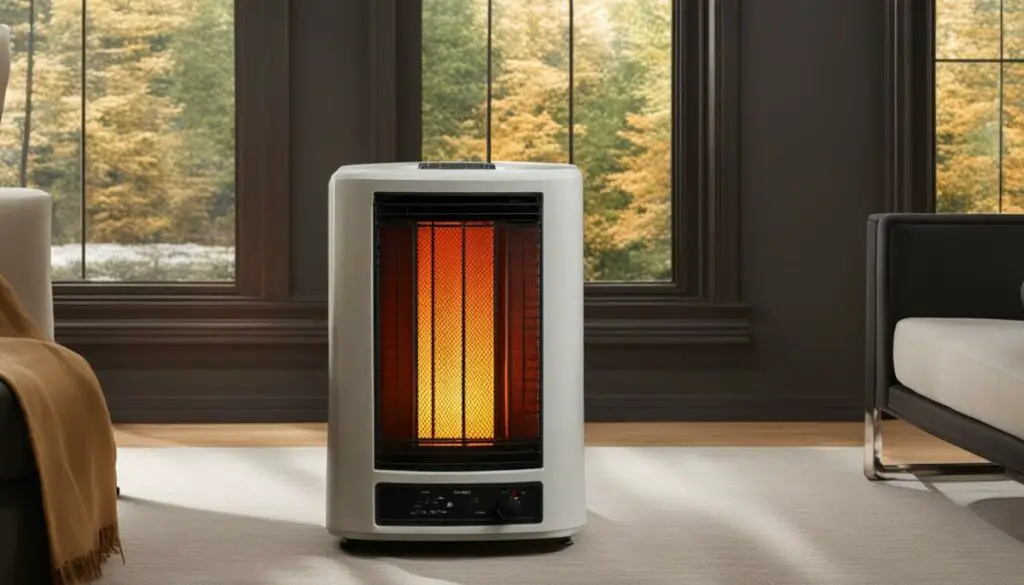
When it comes to outdoor heating, radiant outdoor heaters are a popular choice for providing warmth in open spaces. These heaters utilize infrared heat to directly warm people and objects, rather than heating the air around them. However, it is important to note that radiant outdoor heaters are not suitable for indoor use due to specific ventilation requirements and safety concerns.
Radiant outdoor heaters typically burn natural gas or propane to generate heat. As a byproduct of this combustion, carbon monoxide (CO) is produced. In outdoor spaces, CO can safely dissipate into the open air. However, when used indoors, the lack of proper ventilation can lead to a buildup of CO, posing a serious health risk to occupants.
It is crucial to understand that even with proper ventilation, radiant outdoor heaters should never be used indoors. Ventilation alone cannot fully eliminate the risk of CO poisoning. Indoor spaces require heating solutions that are specifically designed and certified for indoor use. These heaters incorporate safety features and are built to meet strict emission standards, ensuring the well-being of occupants.
To summarize, while radiant outdoor heaters provide effective heating solutions for outdoor spaces, they should never be used indoors. The risk of carbon monoxide poisoning is a serious concern, and only certified indoor heaters should be used to provide safe and efficient heating for indoor environments.
Indoor Gas Heaters as Safe Alternatives
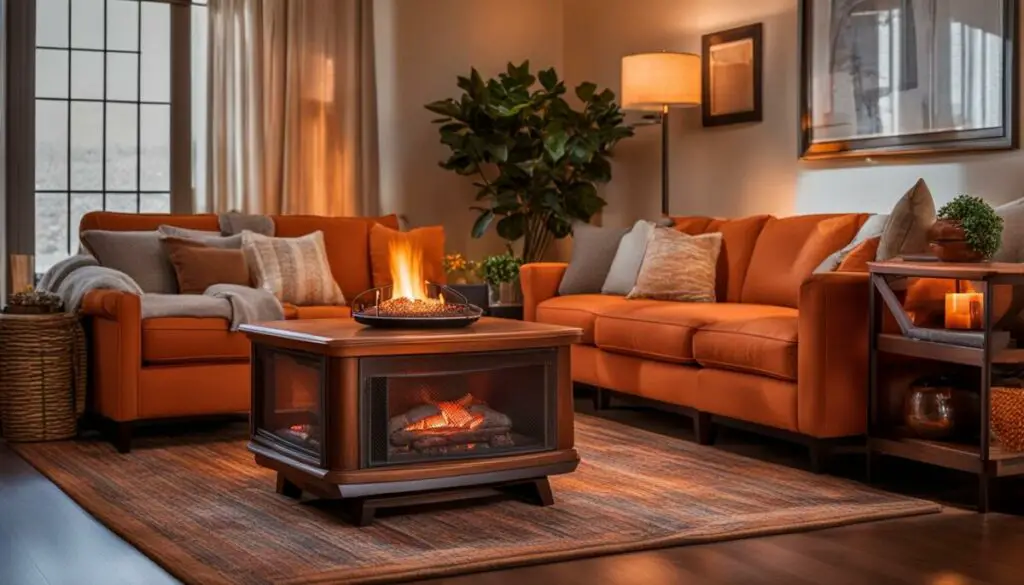
When it comes to heating homes safely, indoor gas heaters are a reliable choice. These heaters are specifically designed and certified for indoor use, providing warmth and comfort without compromising safety. With various types available, including radiant, convector, and wall heaters, there is a suitable option for every space.
Indoor gas heaters prioritize safety with built-in features and compliance with strict emission standards. They are designed to minimize the production of carbon monoxide, ensuring the well-being of your family. By following the manufacturer’s instructions for safe operation and regular maintenance, you can enjoy the benefits of efficient heating without worrying about harmful emissions or accidents.
Table:
| Type of Indoor Gas Heaters | Description | Safety Features |
|---|---|---|
| Radiant Heaters | Warm specific areas by emitting infrared heat | Low surface temperature, oxygen depletion sensor |
| Convector Heaters | Circulate warm air throughout the room | Overheat protection, thermostat control |
| Wall Heaters | Mounted on walls for space-saving heating | Child lock, flame failure detection, carbon monoxide sensor |
The Importance of Family Safety
When it comes to keeping your family safe, it’s crucial to understand the risks associated with using propane heaters indoors. While infrared propane heaters can provide warmth and comfort, it’s important to follow proper safety measures to prevent accidents and ensure the well-being of your loved ones.
One of the key risks of using propane heaters indoors is the potential for carbon monoxide poisoning. Outdoor propane heaters emit combustion gases that include carbon monoxide, which can be extremely dangerous in enclosed spaces. To avoid this risk, it’s essential to only use propane heaters that are specifically designed and certified for indoor use.
To protect your family, it’s important to prioritize safety by following the manufacturer’s instructions and guidelines for safe operation. Regular maintenance and inspections are also necessary to ensure that the heater is in good working condition and free from any potential hazards. By taking these precautions, you can enjoy the benefits of infrared propane heaters while keeping your family safe.
Remember, family safety should always be a top priority. Avoid using outdoor propane heaters indoors and opt for certified indoor heaters that meet necessary safety standards. By following the recommended safety measures and staying informed about the potential risks, you can create a warm and safe environment for your loved ones.
“Safety should never be compromised when it comes to using propane heaters indoors. Always prioritize the well-being of your family and ensure that you are using certified indoor heaters designed for safe indoor use.”
| Indoor Propane Heater Safety Tips |
|---|
| Only use propane heaters certified for indoor use. |
| Follow the manufacturer’s instructions for safe operation. |
| Ensure proper ventilation to prevent carbon monoxide buildup. |
| Regularly inspect and maintain the heater for any potential hazards. |
| Keep the heater away from flammable materials and ensure electrical safety. |
Conclusion
Ensuring the safe and efficient use of infrared propane heaters indoors requires following a set of best practices. By adhering to these guidelines, you can enjoy the warmth and comfort provided by these heaters without compromising safety.
First and foremost, proper ventilation is crucial. Make sure that the area where the heater is used has adequate air circulation. This will help prevent the accumulation of harmful gases and maintain a healthy indoor environment.
Additionally, it’s important to maintain a safe distance between the heater and other objects, especially flammable materials. Keep the heater at least three feet away from any potential hazards to reduce the risk of fire or damage to the surrounding area.
Lastly, ensure that the electrical safety of the heater is maintained. Regularly inspect the cords and connections for any signs of damage or wear. Always plug the heater directly into a grounded outlet and avoid using extension cords.
FAQ
Are infrared propane heaters safe to use indoors?
According to experts, infrared propane heaters used indoors are generally safe when proper safety precautions are taken.
What safety precautions should I take when using infrared propane heaters indoors?
To ensure the safe use of infrared propane heaters indoors, it is essential to follow certain safety precautions. These include considering the certification of the heaters, distinguishing between outdoor and indoor propane heaters, and understanding the differences in design and construction.
Can I use outdoor propane heaters indoors?
No, using outdoor propane heaters indoors can be extremely dangerous and potentially fatal due to the production of carbon monoxide.
What is the difference between indoor gas heaters and outdoor heaters?
Indoor gas heaters are designed to minimize or eliminate the production of carbon monoxide and incorporate safety features such as flues to vent combustion gases outdoors. Outdoor heaters, on the other hand, are not subjected to the same emission standards and should not be used indoors.
Are radiant outdoor heaters safe to use indoors?
No, radiant outdoor heaters should always remain outdoors to ensure safety and proper ventilation.
What are safe alternatives for indoor heating?
Indoor gas heaters designed and certified for indoor use provide a safe alternative for heating homes. Look for gas heaters certified for indoor use and follow the manufacturer’s instructions for safe operation.
How can I prioritize family safety when using propane heaters indoors?
To prioritize family safety, avoid using outdoor heaters indoors and opt for certified indoor heaters that meet necessary safety standards. Regular maintenance and inspections are also important.
Are infrared propane heaters safe for indoor use?
Infrared propane heaters can be safe for indoor use if the proper safety precautions are followed, including maintaining proper ventilation, avoiding close contact, and ensuring electrical safety.


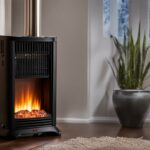
.jpg)

.jpg)



